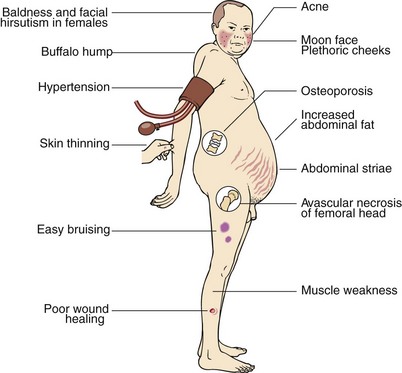Hyperfunction of the adrenal cortex
Cortisol excess
Prolonged exposure of body tissues to cortisol or other glucocorticoids gives rise to the clinical features that collectively are known as Cushing’s syndrome (Fig 49.1), after the American neurosurgeon Harvey Cushing. It most often results from prolonged use of steroid medications (iatrogenic). Much less frequently, it is caused by tumours that secrete either cortisol or ACTH (see below); these can sometimes be very difficult to diagnose.
In any investigation of Cushing’s syndrome the clinician should ask two questions:
 ‘Does the patient actually have Cushing’s syndrome?’ The possibility that a patient may have Cushing’s syndrome frequently arises because they are obese or hypertensive, conditions frequently encountered in the population at large. Initial investigations will in most cases exclude the diagnosis of Cushing’s syndrome.
‘Does the patient actually have Cushing’s syndrome?’ The possibility that a patient may have Cushing’s syndrome frequently arises because they are obese or hypertensive, conditions frequently encountered in the population at large. Initial investigations will in most cases exclude the diagnosis of Cushing’s syndrome.
 Once the diagnosis of Cushing’s syndrome is established, then a second question may be asked: ‘What is the cause of the excess cortisol secretion?’ Tests used in the differential diagnosis are different from those used to confirm the presence of cortisol overproduction.
Once the diagnosis of Cushing’s syndrome is established, then a second question may be asked: ‘What is the cause of the excess cortisol secretion?’ Tests used in the differential diagnosis are different from those used to confirm the presence of cortisol overproduction.





